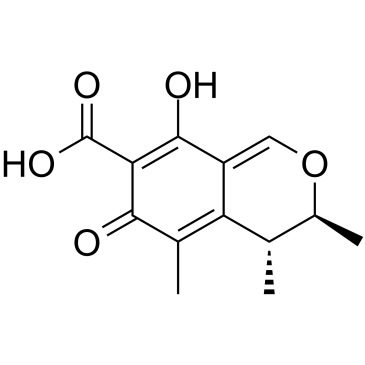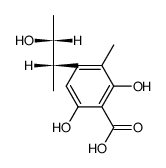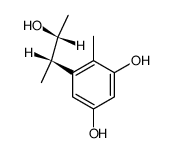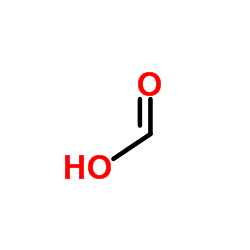518-75-2
| 中文名 | 桔霉素 |
|---|---|
| 英文名 | (-)-citrinin |
| 中文别名 |
桔青霉素
橘青霉素 橘霉素 |
| 英文别名 |
(3R,4S)-8-Hydroxy-3,4,5-trimethyl-6-oxo-4,6-dihydro-3H-isochromene-7-carboxylic acid
4,6-dihydro-8-hydroxy-3,4,5-trimethyl-6-oxo-3H-isochromene-7-carboxylic acid Citriain Citrinin Cytrinine (3R,4S)-4,6-dihydro-8-hydroxy-3,4,5-trimethyl-6-oxo-3H-2-benzopyran-7-carboxylic acid citrinin,antimycin CIT (-)-Citrinin MFCD00006912 ,(3r-trans) EINECS 208-257-2 |
| 描述 | Citrinin 是一种引起食品污染的真菌毒素,具有不同的毒性作用。Citrinin 通常与另一种肾毒性真菌毒素 Ochratoxin A 一起发现。Citrinin 据报道在体外具有广泛的生物活性,包括抗菌、抗真菌和潜在的抗癌和神经保护作用。 |
|---|---|
| 相关类别 | |
| 参考文献 |
| 密度 | 1.4±0.1 g/cm3 |
|---|---|
| 沸点 | 409.8±45.0 °C at 760 mmHg |
| 熔点 | 175°C (dec.) |
| 分子式 | C13H14O5 |
| 分子量 | 250.247 |
| 闪点 | 156.6±22.2 °C |
| 精确质量 | 250.084122 |
| PSA | 83.83000 |
| LogP | 1.20 |
| 外观性状 | 黄色粉末、晶体或薄片 |
| 蒸汽压 | 0.0±2.2 mmHg at 25°C |
| 折射率 | 1.596 |
| 储存条件 | 1.2-8°C储存于阴凉、干燥、通风良好的库房。远离火种、热源。防止阳光直射。包装密封。应与酸类、食用化学品分开存放,切忌混储。储区应备有合适的材料收容泄漏物。 |
| 稳定性 | 按规格使用和贮存,不会发生分解,避免与氧化物接触 |
| 分子结构 | 1、 摩尔折射率:61.73 2、 摩尔体积(cm3/mol):181.5 3、 等张比容(90.2K):496.4 4、 表面张力(dyne/cm):55.9 5、 极化率(10-24cm3):24.47 |
| 计算化学 | 1、 疏水参数计算参考值(XlogP):2 2、 氢键供体数量:2 3、 氢键受体数量:5 4、 可旋转化学键数量:0 5、 互变异构体数量:11 6、 拓扑分子极性表面积(TPSA):83.8 7、 重原子数量:18 8、 表面电荷:0 9、 复杂度:532 10、 同位素原子数量:0 11、 确定原子立构中心数量:2 12、 不确定原子立构中心数量:0 13、 确定化学键立构中心数量:0 14、 不确定化学键立构中心数量:0 15、 共价键单元数量:1 |
| 更多 | 1. 性状:未确定 2. 密度(g/ cm3,25/4℃):未确定 3. 相对蒸汽密度(g/cm3,空气=1):未确定 4. 熔点(ºC):175 5. 沸点(ºC,常压):未确定 6. 沸点(ºC,8kPa):未确定 7. 折射率:未确定 8. 闪点(ºF):未确定 9. 比旋光度(º):未确定 10. 自燃点或引燃温度(ºC):未确定 11. 蒸气压(kPa,25ºC):未确定 12. 饱和蒸气压(kPa,60ºC):未确定 13. 燃烧热(KJ/mol):未确定 14. 临界温度(ºC):未确定 15. 临界压力(KPa):未确定 16. 油水(辛醇/水)分配系数的对数值:未确定 17. 爆炸上限(%,V/V):未确定 18. 爆炸下限(%,V/V):未确定 19. 溶解性:溶于甲醇、乙醇、丙酮、乙酸乙酯、苯、正己烷等。 |
Synonym:None Section 2 - COMPOSITION, INFORMATION ON INGREDIENTS
Risk Phrases: 23/24/25 Section 3 - HAZARDS IDENTIFICATION EMERGENCY OVERVIEW
Toxic by inhalation, in contact with skin and if swallowed.Cancer suspect agent.The toxicological properties of this material have not been fully investigated. Potential Health Effects Eye: May cause eye irritation. Skin: May cause skin irritation. Harmful if absorbed through the skin. Ingestion: Harmful if swallowed. May cause irritation of the digestive tract. The toxicological properties of this substance have not been fully investigated. Inhalation: Harmful if inhaled. May cause respiratory tract irritation. The toxicological properties of this substance have not been fully investigated. Chronic: No information found. Section 4 - FIRST AID MEASURES Eyes: Flush eyes with plenty of water for at least 15 minutes, occasionally lifting the upper and lower eyelids. Get medical aid. Skin: Get medical aid. Flush skin with plenty of water for at least 15 minutes while removing contaminated clothing and shoes. Wash clothing before reuse. Ingestion: Never give anything by mouth to an unconscious person. Get medical aid. Do NOT induce vomiting. If conscious and alert, rinse mouth and drink 2-4 cupfuls of milk or water. Inhalation: Remove from exposure and move to fresh air immediately. If not breathing, give artificial respiration. If breathing is difficult, give oxygen. Get medical aid. Notes to Physician: Section 5 - FIRE FIGHTING MEASURES General Information: As in any fire, wear a self-contained breathing apparatus in pressure-demand, MSHA/NIOSH (approved or equivalent), and full protective gear. During a fire, irritating and highly toxic gases may be generated by thermal decomposition or combustion. Extinguishing Media: Use agent most appropriate to extinguish fire. Use water spray, dry chemical, carbon dioxide, or appropriate foam. Section 6 - ACCIDENTAL RELEASE MEASURES General Information: Use proper personal protective equipment as indicated in Section 8. Spills/Leaks: Clean up spills immediately, observing precautions in the Protective Equipment section. Sweep up or absorb material, then place into a suitable clean, dry, closed container for disposal. Provide ventilation. Section 7 - HANDLING and STORAGE Handling: Wash thoroughly after handling. Use with adequate ventilation. Avoid contact with eyes, skin, and clothing. Keep container tightly closed. Avoid ingestion and inhalation. Storage: Store in a tightly closed container. Store in a cool, dry, well-ventilated area away from incompatible substances. Hormones and antibiotics room. Section 8 - EXPOSURE CONTROLS, PERSONAL PROTECTION Engineering Controls: Facilities storing or utilizing this material should be equipped with an eyewash facility and a safety shower. Use adequate ventilation to keep airborne concentrations low. Exposure Limits CAS# 518-75-2: Personal Protective Equipment Eyes: Wear appropriate protective eyeglasses or chemical safety goggles as described by OSHA's eye and face protection regulations in 29 CFR 1910.133 or European Standard EN166. Skin: Wear appropriate protective gloves to prevent skin exposure. Clothing: Wear appropriate protective clothing to prevent skin exposure. Respirators: A respiratory protection program that meets OSHA's 29 CFR 1910.134 and ANSI Z88.2 requirements or European Standard EN 149 must be followed whenever workplace conditions warrant respirator use. Section 9 - PHYSICAL AND CHEMICAL PROPERTIES Physical State: Crystalline powder Color: yellow Odor: Not available. pH: Not available. Vapor Pressure: Not available. Viscosity: Not available. Boiling Point: Not available. Freezing/Melting Point: Not available. Autoignition Temperature: Not available. Flash Point: Not available. Explosion Limits, lower: Not available. Explosion Limits, upper: Not available. Decomposition Temperature: Solubility in water: Specific Gravity/Density: Molecular Formula: C13H14O5 Molecular Weight: 250.25 Section 10 - STABILITY AND REACTIVITY Chemical Stability: Stability unknown. Conditions to Avoid: Incompatible materials. Incompatibilities with Other Materials: Oxidizing agents. Hazardous Decomposition Products: Irritating and toxic fumes and gases. Hazardous Polymerization: Has not been reported Section 11 - TOXICOLOGICAL INFORMATION RTECS#: CAS# 518-75-2: DJ2275000 LD50/LC50: CAS# 518-75-2: Oral, mouse: LD50 = 105 mg/kg; Oral, rabbit: LD50 = 134 mg/kg. Carcinogenicity: Citrinin - Not listed by ACGIH, IARC, or NTP. Other: See actual entry in RTECS for complete information. Section 12 - ECOLOGICAL INFORMATION Other No information available. Section 13 - DISPOSAL CONSIDERATIONS Dispose of in a manner consistent with federal, state, and local regulations. Section 14 - TRANSPORT INFORMATION IATA Shipping Name: TOXIC SOLID, ORGANIC, N.O.S.* Hazard Class: 6.1 UN Number: 2811 Packing Group: II IMO Shipping Name: TOXIC SOLID, ORGANIC, N.O.S. Hazard Class: 6.1 UN Number: 2811 Packing Group: II RID/ADR Shipping Name: TOXIC SOLID, ORGANIC, N.O.S. Hazard Class: 6.1 UN Number: 2811 Packing group: II Section 15 - REGULATORY INFORMATION European/International Regulations European Labeling in Accordance with EC Directives Hazard Symbols: T Risk Phrases: R 23/24/25 Toxic by inhalation, in contact with skin and if swallowed. Safety Phrases: S 28A After contact with skin, wash immediately with plenty of water. S 36/37/39 Wear suitable protective clothing, gloves and eye/face protection. S 37 Wear suitable gloves. S 45 In case of accident or if you feel unwell, seek medical advice immediately (show the label where possible). WGK (Water Danger/Protection) CAS# 518-75-2: No information available. Canada None of the chemicals in this product are listed on the DSL/NDSL list. CAS# 518-75-2 is not listed on Canada's Ingredient Disclosure List. US FEDERAL TSCA CAS# 518-75-2 is not listed on the TSCA inventory. It is for research and development use only. SECTION 16 - ADDITIONAL INFORMATION N/A |
|
生态学数据: 该物质对环境可能有危害,对水体应给予特别注意。 CHEMICAL IDENTIFICATION
HEALTH HAZARD DATAACUTE TOXICITY DATA
MUTATION DATA
|
| 符号 |


GHS02, GHS07 |
|---|---|
| 信号词 | Danger |
| 危害声明 | H225-H302-H312-H319-H332 |
| 警示性声明 | P210-P280-P305 + P351 + P338 |
| 个人防护装备 | Eyeshields;Faceshields;full-face particle respirator type N100 (US);Gloves;respirator cartridge type N100 (US);type P1 (EN143) respirator filter;type P3 (EN 143) respirator cartridges |
| 危害码 (欧洲) | T |
| 风险声明 (欧洲) | 23/24/25-40-36/37/38 |
| 安全声明 (欧洲) | S26-S36/37/39-S45 |
| 危险品运输编码 | UN 3462 6.1/PG 3 |
| WGK德国 | 3 |
| RTECS号 | DJ2275000 |
| 包装等级 | II |
| 危险类别 | 6.1(a) |
|
~% 
518-75-2 |
| 文献:Warren et al. Journal of the American Chemical Society, 1949 , vol. 71, p. 3422 Full Text View citing articles Show Details Schwenk; Schubert; Stahl Archives of Biochemistry, 1949 , vol. 20, p. 220,226 |
|
~% 
518-75-2 |
| 文献:Roedel, Thomas; Gerlach, Hans Liebigs Annalen, 1995 , # 5 p. 885 - 888 |

518-75-2 ~% 
518-75-2 |
| 文献:Johnson et al. Journal of the Chemical Society, 1950 , p. 2971,2973 |
|
~% 
518-75-2 |
| 文献:Asano et al. Yakugaku Zasshi, 1951 , vol. 71, p. 268,270 Chem.Abstr., 1952 , p. 485 |
|
~% 
518-75-2 |
| 文献:Cartwright; Robertson; Whalley Journal of the Chemical Society, 1949 , p. 1563,1566 |
|
~% 
518-75-2 |
| 文献:Wang; Ting Science Record (Peking), 1951 , vol. 4, p. 269,270 |
|
~% 
518-75-2 |
| 文献:Cartwright; Robertson; Whalley Journal of the Chemical Society, 1949 , p. 1563,1566 |








